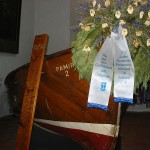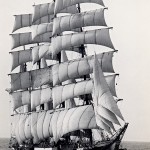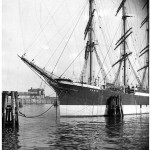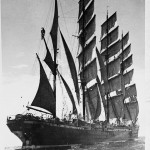 In a corner of St. Jacob’s Church (known as the seafarers church) in Lubeck, Germany is a memorial to the windjammer Pamir. The memorial is simple – a salvaged lifeboat from the stricken ship and a board listing the names of the 80 souls who were lost at sea in September 1957 off the Azones.
In a corner of St. Jacob’s Church (known as the seafarers church) in Lubeck, Germany is a memorial to the windjammer Pamir. The memorial is simple – a salvaged lifeboat from the stricken ship and a board listing the names of the 80 souls who were lost at sea in September 1957 off the Azones.
This website is devoted to memorials to those lost at sea, but sometimes it is difficult to ignore the history of some of the proud and beautiful ships that also rest at the bottom of the world’s oceans.
The Pamir was one of the last great windjammers. The four-masted barque was built in Hamburg and launched in July 1905. She was the fifth of ten near sister ships – with a length of 375 feet, a beam of 46 feet, with three main masts that stood 168 feet above her deck. She was capable of deploying over 40,000 square feet of sail area. She carried grain and nitrates to and from Europe, Asia and South America until WWII. In August 1941 she was serving under the flag of Finland.
During WWII she was seized as a war prize by New Zealand, continuing to haul freight during the entire conflict. She made numerous trips from New Zealand to San Francisco, Vancouver and Sydney. In 1948 she was returned to the Erikson Line of Finland, where she resumed hauling Australian grain to Europe. In 1949 she hauled barley from Australia to England, becoming the last windjammer to carry a commercial load around Cape Horn. In the early 1950s she was sold to a German consortium. where she was used as a cargo-carrying school ship on a route primarily between Germany and Argentina.
On August 10, 1957 the Pamir left Buenos Aires for Hamburg with a crew of 86, including 52 merchant marine cadets. On September 21, 1957 she was caught in Hurricane Carrie before shortening sails. She was apparently unaware of the hurricane, being caught with open hatchways. Considerable water entered the ship, the grain cargo shifted and the ship listed severely to port. Her port side eventually went underwater, leading to her loss.
The ship was able to send three distress signals before sinking. A nine-day search for survivors was organized by the United States Coast Guard, but only four crew members and two cadets were ever found. The rest of the crew perished 600 miles west-southwest of the Azores. None of the ship’s officers survived, so there was never any testimony as to how the ship was caught so unprepared for the hurricane.
The memorial in St. Jacob’s Church displays one of the two lifeboats that were eventually found.
Two ships very similar to Pamir can still be seen – the Peking at the South Street Seaport in New York City and the Passat in Travemunde, Germany. Several fine books can also be found that describe the history and final voyage of Pamir:
The Last Time Around Cape Horn by William Stark
The Pamir under the New Zealand Ensign by Jack Churchouse
Tall Ships Down by Daniel Parrott



Jurgen Grubert via Cameron Grubert said:
Around ’56, I was an officers’ mess steward on the Olympia cruise ship and saw the Pamir with all sails up in the North Atlantic. When I saw a flat-mirror ocean and the Pamir with all sails up, it was a beautiful day.
Ekke Nielsen said:
In 1956-57 I lived in Buenos Aires. The arrival of the great German windjammers were a sensation and i took the opportunity to visit then on several occasions. The Plattdeutsche vereinigung an dem La Plata arranged dancing’s in the Restaurante Nino, where we had a real good time. They were also invited to the German sports club om some ocasions.
I was a teenager at the time end very impressed.
I later became e marine engineer in the Swedish merchant navy.
Lily A. Peper said:
I lived in Bs. As. and met a few sailers at the German Club with my sister I was 17 then I was invited to a movie with a officer named Rolf Hagge that transfered from the Pamir to the Cap Finisterre Ship so he was lucky not to be on the Pamir trajic demise. I immigrated to the Unites States when this horrible accident occured and needles to say I was devastated. The distance and my move to the States tore my friendship with Rolf apart, I was so glad that he was OK. What a sad memory and yet I was so happy to have seen this beautiful ship.
Paul Menzies said:
My father was assistant radio officer on the pair during ww11 under the new Zealand flag. His time on this fine ship was one of the great memories of his life. I have many black and white photos of this beautifully ship.
Philippe Bellamit said:
Feel free to contribute any interesting picture to the Pamir Memorial.
Doug Bjotvedt said:
I was first told the story of the loss of the Pamir when I was 12 years old (1980) and visiting my grandparents for the Summer in Norway. My Grandfather was the Captain of the Saxon whom rescued 5 of the 6 survivors. I am working on a human interest article and will provide some photos afterwards.
Petrina Bayliss said:
My Dad, Peter Kearney, was a crew member on the MV Wendover and remembers responding to the SOS from the Pamir.
He was 18 at the time but recalls the tragedy clearly, probably because of the loss of so many souls and so young too.
Dad tells me about how scary it was on board the ship during Hurricane Carrie and how they helped search for survivors, sadly unsuccessfully.
Heinrich Koopmann said:
I was On Pamir when we went to Buenos Aires. The country was mourning over the loss of Evita Peron.
We were invited to a Dinner by President Juan Peron.
I wonder if there are still some pictures from this remarkable Day
Phil Short said:
I have discovered a Plaque well fixed to a tree dedicated to the ships company who were lost on the Pamir on South Stradbroke Island in Queensland Aus..The area is now in the hands of the Southport Yacht Club and the previous owner’s were the Dux family oyster farmers in the area.
Looking back through Dux family they were from Germany.
Would like to know more abut the crew if were any relation ‘s to the Dux family onboard Angie Dux died in 1962.
The club is going to restore the area as a memorial to all lost at sea.